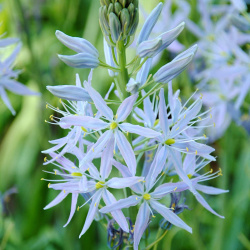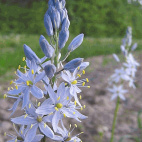Blue Camass Seeds
Camassia quamash
- HOW TO GROW
- FAST FACTS
HOW TO GROW
Sowing: For best results, direct sow outdoors in the fall; plant just below the surface of the soil. This seed may be slow to germinate, taking anywhere from 1-6 months. For spring planting, mix the seed with moist sand and store it in the refrigerator for 60 days before planting.
Growing: Though it adapts to many soils including sand, this plant prefers moist, fairly heavy soil such as clay. It develops rather slowly, and may not bloom until several years after sprouting. Seedlings need regular watering as they become established, and mature plants may also need occasional watering in blooming season. High heat or excess moisture may cause this plant to stop blooming or go dormant. After blooming the plant will wither and go dormant until next year; the stem can be cut down after blooming has finished, though this will prevent the development of seed. If left to self-seed, this plant will produce volunteer seedlings. It attracts butterflies, hummingbirds, and bees.
Harvesting: Blue Camass makes an excellent cut flower; cut the stems long and place them in water immediately. The edible bulbs can be harvested from mature plants at any time in the fall. When harvesting bulbs, keep in mind that the poisonous Death Camas often grows near this plant.
Seed Saving: When the seed heads begin to dry and contain mature black seed, remove them and spread them out to dry. Thresh to remove the seed. Store the seed in a cool, dry place.
FAST FACTS
Common Names: Small Camas, Common Camass, Camas Lily, Swamp Sego
Latin Name: Camassia quamash
Species Origin: US Native Wildflower
Type: Native Wildflowers
Life Cycle: Perennial
USDA Zones: 4, 5, 6, 7, 8, 9
US Regions: California, Mountain, Arid/Desert
Seeds per Ounce: 3,700
Stratification: Cold/Wet for 8 Weeks
Germination Ease: Stratify 8 Weeks
Sunlight: Full Sun
Height: 20 Inches
Color: Blue
Bloom Season: Blooms Late Spring
DESCRIPTION

HOW TO GROW
Sowing: For best results, direct sow outdoors in the fall; plant just below the surface of the soil. This seed may be slow to germinate, taking anywhere from 1-6 months. For spring planting, mix the seed with moist sand and store it in the refrigerator for 60 days before planting.
Growing: Though it adapts to many soils including sand, this plant prefers moist, fairly heavy soil such as clay. It develops rather slowly, and may not bloom until several years after sprouting. Seedlings need regular watering as they become established, and mature plants may also need occasional watering in blooming season. High heat or excess moisture may cause this plant to stop blooming or go dormant. After blooming the plant will wither and go dormant until next year; the stem can be cut down after blooming has finished, though this will prevent the development of seed. If left to self-seed, this plant will produce volunteer seedlings. It attracts butterflies, hummingbirds, and bees.
Harvesting: Blue Camass makes an excellent cut flower; cut the stems long and place them in water immediately. The edible bulbs can be harvested from mature plants at any time in the fall. When harvesting bulbs, keep in mind that the poisonous Death Camas often grows near this plant.
Seed Saving: When the seed heads begin to dry and contain mature black seed, remove them and spread them out to dry. Thresh to remove the seed. Store the seed in a cool, dry place.
FAST FACTS
Common Names: Small Camas, Common Camass, Camas Lily, Swamp Sego
Latin Name: Camassia quamash
Species Origin: US Native Wildflower
Type: Native Wildflowers
Life Cycle: Perennial
USDA Zones: 4, 5, 6, 7, 8, 9
US Regions: California, Mountain, Arid/Desert
Seeds per Ounce: 3,700
Stratification: Cold/Wet for 8 Weeks
Germination Ease: Stratify 8 Weeks
Sunlight: Full Sun
Height: 20 Inches
Color: Blue
Bloom Season: Blooms Late Spring









